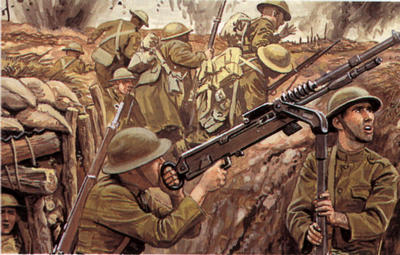Friday, January 1, 2016
WAR SHORT STORY: A Daisy-Chain of Bandoliers
“A Daisy-Chain of Bandoliers” is set on the Western Front in WWI. The author was Private W.H. Cooperwaite who served in the 2nd Battalion, Durham Light Infantry. The story is obviously a fictionalized account of some incidents during his stay at the front. He tells the story in flashback form as at the beginning he is wounded by a German shell called a “Jack Johnson”. He assumes his readers will recognize that the large shell was named after a famous African)-American boxer. He points out that he was hit by shrapnel from the only one of eighteen shells that actually exploded. It is seldom you read about the high percentage of duds in WWI. The rest of the story is a series of vignettes. He mentions German atrocities like the murder of two young girls. The Germans can also be devious. He describes what he calls the “stretcher dodge” in which a German unit pretended to surrender and then when the Brits had been lulled into complacency, the Germans opened fire with machine guns concealed on stretchers. He goes on to tell of some combat incidents. He unit has to make a suicidal attack up a hill against a strong German position. A beloved officer goes down and several men die bringing him in only to have him die anyway. This serves as a good summary of the fighting on the Western Front, but Cooperwaite does not delve into the irony or symbolism of the incident. An interesting vignette is about a unit of Gurkhas stationed nearby. Cooperwaite describes a counterattack by the Turks featuring their curved knives. “They seemed all grin and knife as they returned.” The title comes from the concluding episode that involved delivering ammunition to the front line trench. They tie the bandoliers together into a daisy-chain to try to cover the last few yards, but this is futile - like the war.
“A Daisy-Chain of Bandoliers” is nothing special. In fact, Cooperwaite is not a particularly good writer. There are some aggravating grammar problems, for instance. He tends to write in soldier vernacular. He describes shells as creating “mischief”. There is no real connection between the vignettes. The story does not flow. Some of it is propagandistic and smacks of the early days of the war when the Germans were accused of all sorts of atrocities. I have found no evidence for the Germans using a “stretcher dodge”. I’m not saying it did not happen. I’m just skeptical about it. This skepticism colors my view of the whole piece, leaving me wondering if there is much value to it as a war story.
GRADE = D
Next story: "The Duke's Disappearance" by Thomas Hardy
Subscribe to:
Post Comments (Atom)

No comments:
Post a Comment
Please fell free to comment. I would love to hear what you think and will respond.